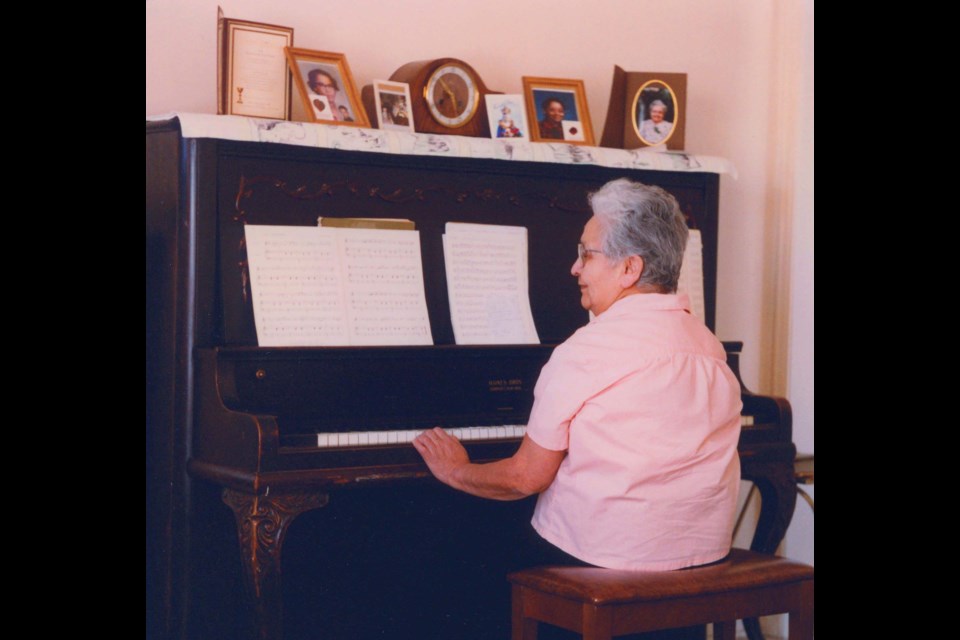DETAILS
Our Songs, Our Roots: Music in St. Albert
Until Jan. 16, 2022
Musée Héritage Museum (St. Albert Place, 5 St. Anne St.)
Call 780-459-1528 or visit museeheritage.ca for more information. Please check in advance to prepare yourself for COVID-19 protocols.
There is a piano in the middle of the Musée Héritage Museum, but the sounds of music are coming from somewhere else. The echoes of the past now fill the space as the exhibit finally hearkens to the rich musical heritage of St. Albert’s past.
Our Songs, Our Roots takes a long loving look — listen? — back to major musical highlights and cultural traditions that have helped to weave notes into our collective quilt.
That piano? It belonged to the famous Beatrice Calliou of the Michel Band (now Calahoo) who played with the Callihoos — including her cousin Richard Callihoo, considered by many to be the elder statesman of Métis fiddling. He won the North American Fiddling Championship several times.
Beatrice was no slouch at the keys either.
“She was a well-known piano player,” curator Joanne White averred, quipping, “She was born a Callihoo and married a Calliou.”
Beatrice Calliou enjoyed music and offered lessons, played the organ, and sang for Cree masses at the Lac Ste. Anne Pilgrimage, plus directed and played organ for the choir at St. Pius Xth Church. Her songs didn’t stop there, as she sang and played for Cree mass at Sacred Heart Church and was well known for her orchestra, Aunty Bea and the Old Timers. She passed away in 2007 an old-timer herself, when she was 84.
She also played with the Andersons, most notably Gilbert Anderson, who was a great fiddler.
“We actually have one of his fiddles and the vest he was wearing when he was photographed for his cassette,” said White.
Anderson, who passed away 10 years ago when he was in his mid-70s, came from a large musical family and inherited a couple of family fiddles. He was reportedly always surrounded by Métis music and taught and promoted fiddle and dance through the Edmonton Métis Cultural Dancers programs. Many of his traditional songs were what he called "Fort Edmonton" tunes.
Music is more than entertainment; it’s a profound source of human communication that has social, cultural, and spiritual dimensions, White explained. That’s why Our Songs, Our Roots explores so much of St. Albert’s multicultural heritage. She calls it the “soundtrack of our community,” something that has always brought people together.
“One of the aspects of the exhibit is the groups that got together and played local dances and events and associations all over the place for decades.”
Centuries even. White noted that The Edmonton Bulletin offers the historical record of a musical house party and dance that was held at Octave Bellerose’s house in 1884. People went “eight or nine miles” to go to this housewarming party, White offered.
“Housewarming parties are a big thing, and weddings. Parties lasted for three days, and everybody brought their instruments and just joined in, and then groups would sometimes blossom out of a family, or a group of friends that got together. Doctor Giroux … played violin. He had a small orchestra with his wife, and sometimes his daughters played, as well as a couple of other gentlemen. They played slightly more classical music. They did a lot of church functions.”
By the 1930s, the raucous house party was far more common, though other halls and venues became available. There was a monthly practice of guests and musicians simply announcing at which house they going to play, bringing food and drink with them. The next month, another house would be announced, and the practice continued with jamming and revelry.
The collection of photos, instruments, recordings, and videos is more comprehensive than one might at first consider. St. Albert radio station CKST Radio (later CFMG) — its first and only — is mentioned, and local musical groups get the same due.
One of the most interesting facets of the show is the importance of music to the Indigenous children who were forced into residential schools. Many of the children, White noted, had strong musical backgrounds with their families but the schools used music to “Europeanize the children.”
“They were able to shine and excel in that in spite of the situation.”
The reputation of the Youville Band went far and led to them participating in both the parade for Queen Victoria’s Diamond Jubilee in Edmonton in 1897 and the celebration of the inauguration of the Province of Alberta in 1905.




